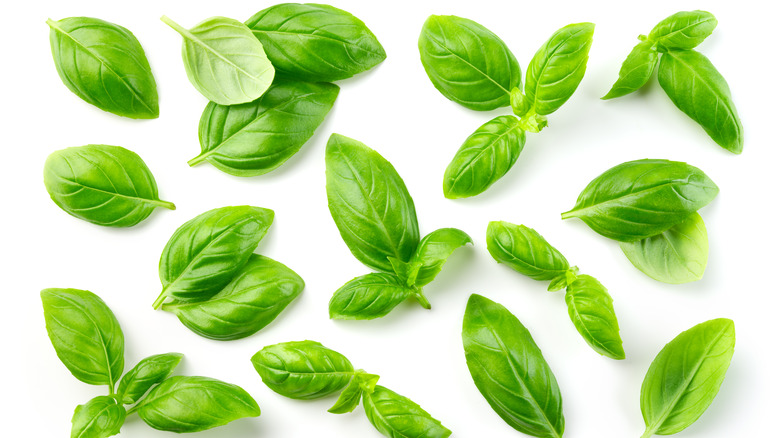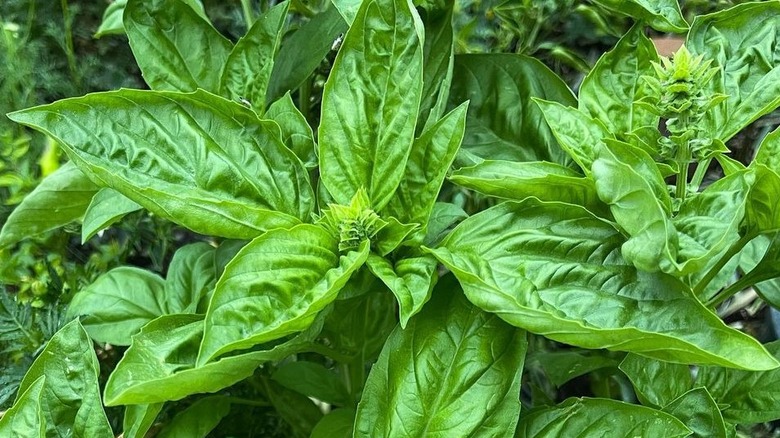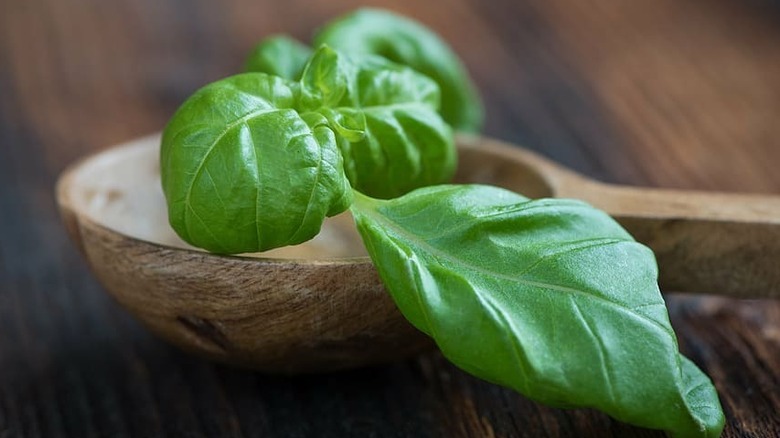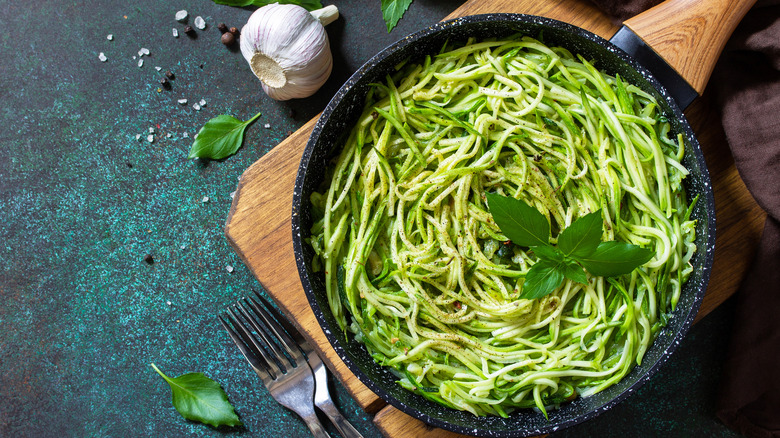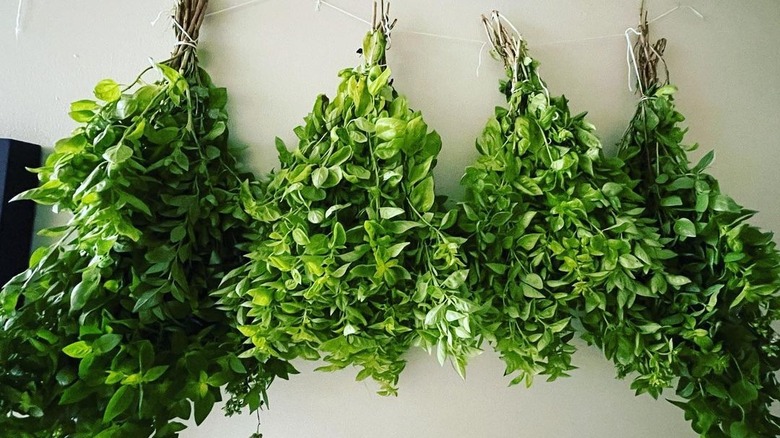What Is Basil And How Do You Cook With It?
If you enjoy the vibrant green color and distinct flavor of pesto sauce on everything from burgers to pasta, you are probably familiar with basil, the versatile herb that lends its distinct flavor profile to the classic Italian sauce. But beyond pesto, there is so much more to basil than meets the eye, and knowing more about it is guaranteed to make you hungry.
Basil (scientifically known as Ocimum basilicum, according to Britannica), is an annual herb hailing from the same family as mint that has shiny, oval-shaped leaves that can be rounded at the edges or slightly pointed. The leaves are edible and delectably aromatic, just like the other members within its family, including lemon balm, peppermint, rosemary, and lavender.
Because basil is a flowering plant, it produces clusters of white or magenta petals, depending on the variety. And as it turns out, there are many different types of basil with distinct taste profiles, ranging from the more commonly used sweet basil to the spicier Thai basil variety (per Taste of Home). Each can be used in a plethora of cooking applications from Italian cooking to Thai and Vietnamese cuisine.
What is basil?
Basil is a very common herb that you can find both fresh and dried in many grocery stores — and it's even termed a kitchen herb (per Taste of Home) because it's easy to grow in your own home. Originally thought to hail from India, says Britannica, today basil is a globally recognized plant that features large, veined leaves that are tender and produce a slightly sweet if not almost peppery taste, says The Spruce Eats.
Perhaps it's because of basil's versatility that it's so widely used — The Spruce Eats mentions there are more than 60 varieties cultivated around the world. But there is much to know about each type and how to properly care for the plant — as well as when it's best used in the kitchen. Common applications include spicing up meat and fish dishes as well as sauces and salads, per Britannica, who also mentions that basil's inherent properties can make a great nutritive tea, too.
How to grow and store your own basil
When picking the right place and time to grow basil at home, it's important to chose wisely and, when possible, opt for times of the year when there's a warm, humid climate, like in the summertime, since the plant is very "frost-sensitive" per Britannica. But if planting an herb garden at your summer home isn't possible, don't fret as you can still grow a lovely bunch of basil by creating the right conditions.
Get a jump on growing your basil by starting it inside, about six weeks before the last spring frost, says The Old Farmer's Almanac. Then, it's best to wait to transfer until the soil outside warms up and nighttime temperatures aren't dipping below 50°F. The source adds that basil makes a great container plant and can easily sit on your windowsill, though it also thrives in a raised garden with well-draining soil along with six to eight hours of sunlight per day.
Here's another hot tip from Gardening Know How – if you want a big, bushy basil plant, simply pinch off the flowers to allow the plant to focus on growing more leaves. If you grow more than you can use, Good Housekeeping says you can simply dry it or freeze it to use at your pleasure. In fact, The Spruce Eats says basil is a great option for freezing. "Whole leaves can be washed or blanched and then flash-frozen and stored in a zip-top bag in the freezer," they note, adding that when you are ready to use the supply, plan to add more than the recipe calls for since freezing it will lose some of the fresh flavor.
What does basil taste like?
As The Spruce Eats notes, basil comes in at least 60 different varieties and each type boasts its own unique flavors. The taste of basil is not loved by all, but its refreshing herbal tones keep those who love it usually coming back for more.
The most commonly used variety found in kitchens, restaurants, and stores is known as sweet basil. Also referred to as Genovese basil, this is the bright green and intoxicatingly aromatic herb often used in Italian and Mediterranean cuisine that serves up notes of mint and anise with a mildly peppery finish, according to A Couple Cooks. Lemon basil is another variety that is similar to sweet basil but has a refreshing citrus scent and flavor, they add.
The purple-stemmed Thai basil plant really packs a punch in the flavor department. Its strong licorice flavor is more of an acquired taste, and it finishes with a spicy kick that will make an impression on your palate, per Victory Seeds. If you're a fan of strong, distinct flavors, another variety to try is holy basil. Fresh Cup Magazine describes it as a pungent but sweet variety that offers notes of clove and licorice.
Whatever flavor profile you prefer, there's a basil variety for you that can bring a refreshing and unique herbal element that will make any dish stand out.
How to cook with basil
When cooking with basil, there are a few classic recipes and dishes that immediately come to mind. But nobody puts basil in a corner, and this flavorsome herb is making its way into some surprising dishes.
Pesto is likely the first recipe that comes to mind when you've got basil on the brain. It's a finely chopped or smoothly blended sauce, originating in Genoa, Italy, that is made from basil leaves combined with toasted pine nuts, Parmesan cheese, olive oil, and garlic, according to Delish. Traditionally tossed with pasta, pesto sauce has proved itself to be more versatile besides pasta and is delicious on everything from roasted chicken to paninis.
You will likely recognize basil as the herb of choice on a Caprese salad as well, which is a simple and refreshing dish made of tomatoes, fresh mozzarella cheese, basil, and a drizzle of olive oil. Margherita pizza is another dish that uses whole basil leaves to lighten up its gooey cheese goodness. However, if you are ready to bust out of the basil box, there are inventive options like basil raspberry tea and basil butter steaks (per Taste of Home) that will blow your mind while expanding your palate.
Welcome the pungently refreshing herbal flavors of basil into your kitchen, and your mouth will be sure to thank you.
Nutritional information about basil
Aside from being an edible herbaceous delight, basil is said to have possible health benefits and maybe even some healing properties. Basil, especially holy basil, is often used in traditional Ayurvedic medicine where it's thought to aid in digestion and promote better sleep, according to Joyful Belly. As well, Web MD adds that dried basil tea is also thought to be a powerful antioxidant elixir that may help with respiratory tract health and possibly reduce inflammation, so cheers to that!
Antioxidants, like those found in basil, are substances that are said to slow down cell deterioration and clear out free radicals from our bodies, and Medical News Today reports that basil is chock full of them. Eugenol and limonene are natural chemical agents that give basil its sniff-worthy aroma, but they also have antioxidant properties that may fight the good fight against oxidative stress. Scientists have found that antioxidants could possibly help fight cancer, lower blood sugar, support liver health, and slow skin aging among other benefits, says another Medical News Today article.
So not only does basil improve your favorite dishes, but it also encourages your well-being, so throw an extra handful into that Caprese salad and enjoy!

